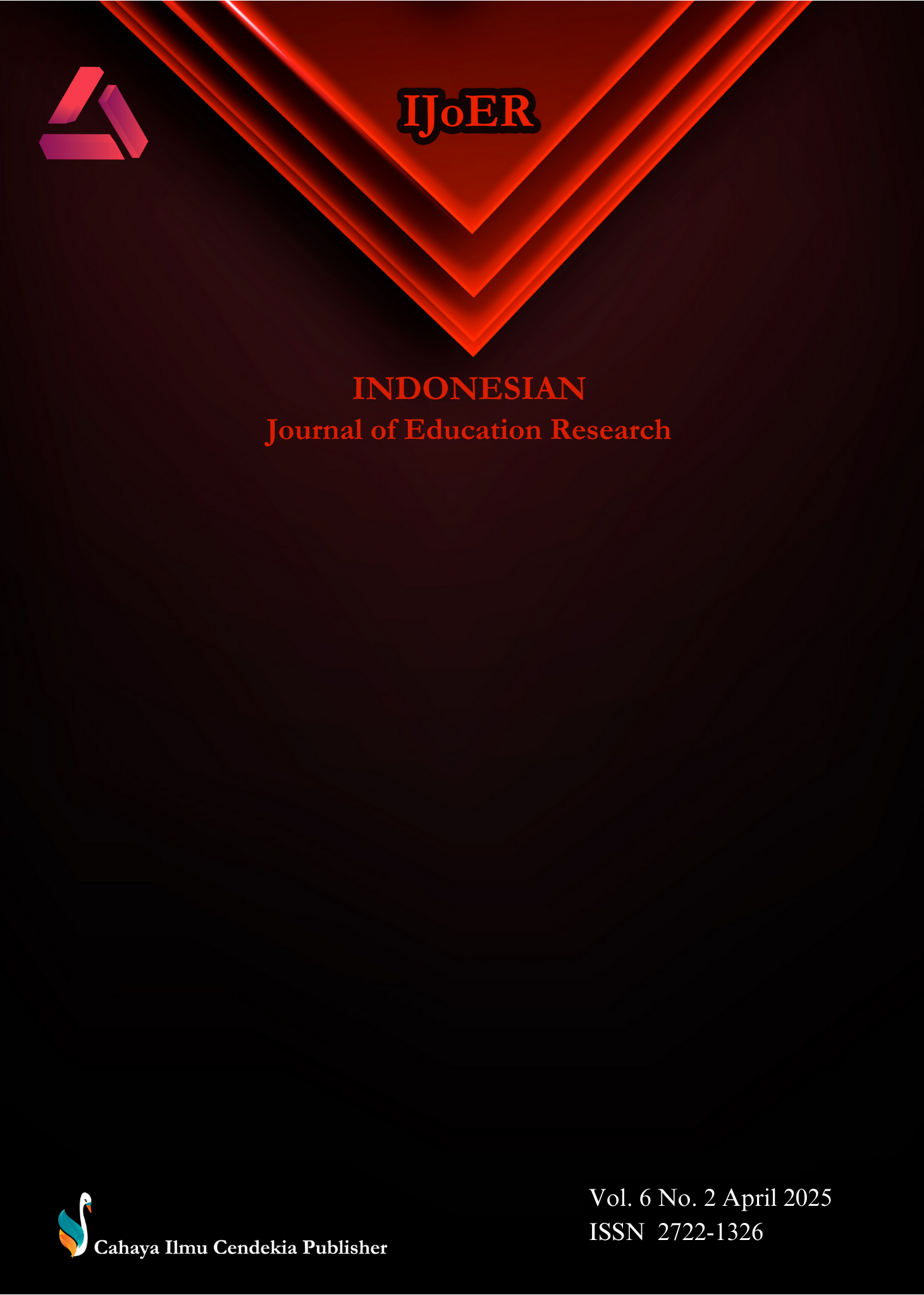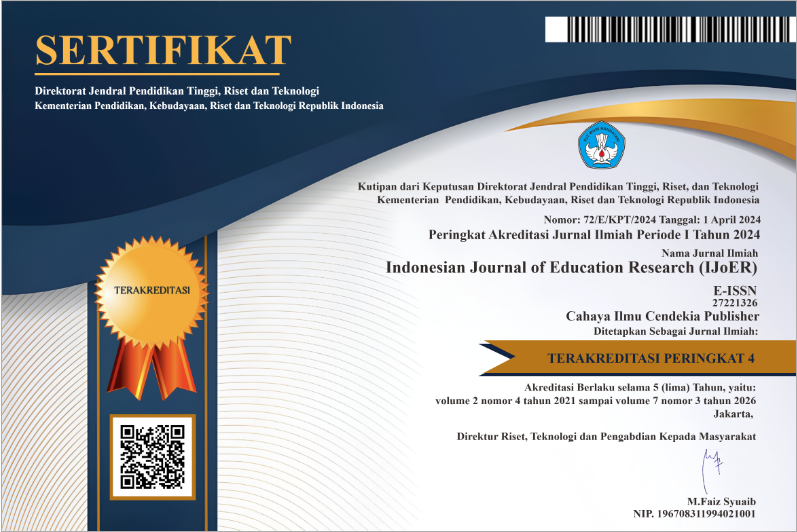Analyzing University Students’ Attitude And Behavior Towards Jesi Program Using Technology Acceptance Model
Abstract
Purpose of the study: This study aimed to examine university students’ attitudes and behavioral intentions toward the JESI Interactive Learning Module using the Technology Acceptance Model (TAM), focusing on perceived ease of use and perceived usefulness.
Methodology: A structured 5-point Likert scale questionnaire adapted from Davis (1989) was distributed via Google Forms. A total of 269 university students were selected using stratified random sampling. Data were analyzed using Partial Least Squares Structural Equation Modeling (PLS-SEM) through SmartPLS 4.0 and descriptive statistics via Jamovi software.
Main Findings: The findings revealed that PU (β = 0.495, p < 0.000) has significant direct effects toward attitude, while PEOU (β = 0.117, p < 0.144) has no significant direct effects toward attitude. Additionally, attitude (β = 0.594, p < 0.00) has also been found to have a significant direct effect toward behavioral intention to use. Additionally, the structural model demonstrated a good-fit in all PLS-SEM indices.
Novelty/Originality of this study: This study is the first to apply TAM to evaluate JESI, a context-specific ILM in Philippine higher education. It advances theoretical understanding of technology acceptance and offers practical insights for improving ILM design and adoption across similar digital platforms in higher education institutions.
References
C. Albrecht, O. Scrivner, G. Allen, and C. Albrecht, “Introduction to the Minitrack on Advances in Teaching and Learning Technologies,” Proc. Hawaii Int. Conf. Syst. Sci., vol. 1, 2020, doi: 10.24251/hicss.2020.002.
I. Sudarsana et al., “Technology application in education and learning process,” J. Phys.: Conf. Ser., vol. 1363, 2019, doi: 10.1088/1742-6596/1363/1/012061.
M. Pastushkova, O. Savateeva, A. Trotsenko, and D. Savateev, “The practical guidelines for implementing modular training in higher education,” Eur. J. Contemp. Educ., vol. 2019, doi: 10.13187/ejced.2019.2.328.
B. Kim, W. Richard, and J. Dattilo, “Students’ perception of interactive learning modules,” J. Res. Technol. Educ., vol. 34, pp. 453–473, 2002, doi: 10.1080/15391523.2002.10782361.
JESI, “FAQs,” JESI, https://um.jesiportal.net/faqs.
F. Leow, “Interactive multimedia learning: Innovating classroom education in a Malaysian university,” Turk. Online J. Educ. Technol., vol. 13, pp. 99–110, 2014.
E. Goode, J. Nieuwoudt, and T. Roche, “Does online engagement matter? The impact of interactive learning modules and synchronous class attendance on student achievement in an immersive delivery model,” Australas. J. Educ. Technol., vol. 2022, doi: 10.14742/ajet.7929.
W. Tarigan, H. Sipahutar, and F. Harahap, “The effect of interactive digital learning module on student’s learning activity and autonomy,” Bioedukasi: J. Pendidik. Biol., vol. 14, no. 2, 2021, doi: 10.20961/bioedukasi-uns.v14i2.49366.
A. Liem, S. Lau, and Y. Nie, “The role of self-efficacy, task value, and achievement goals in predicting learning strategies, task disengagement, peer relationship, and achievement outcome,” Contemp. Educ. Psychol., vol. 33, pp. 486–512, 2008, doi: 10.1016/j.cedpsych.2007.08.001.
S. Kim, “Motivators and concerns for real-time online classes: Focused on the security and privacy issues,” Interact. Learn. Environ., vol. 31, pp. 1875–1888, 2021, doi: 10.1080/10494820.2020.1863232.
X. Jiang, T. Goh, and M. Liu, “On students’ willingness to use online learning: A privacy calculus theory approach,” Front. Psychol., vol. 13, 2022, doi: 10.3389/fpsyg.2022.880261.
A. Farooq, F. Ahmad, N. Khadam, B. Lorenz, and J. Isoaho, “The impact of perceived security on intention to use e-learning among students,” in Proc. IEEE 20th Int. Conf. Adv. Learn. Technol. (ICALT), 2020, pp. 360–364, doi: 10.1109/icalt49669.2020.00115.
S. Sudarman and A. Ardian, “The development of interactive module to support student-centered learning,” Akademika, vol. 10, pp. 77–92, 2021, doi: 10.34005/AKADEMIKA.V10I01.1344.
P. Muthulakshmi and A. Veliappan, “Effectiveness of an interactive multimedia learning package in developing attitude towards mathematics,” J. Sch. Educ. Technol., vol. 11, pp. 40–46, 2016, doi: 10.26634/JSCH.11.3.4789.
A. Hanif, F. Q. Jamal, and M. Imran, “Extending the technology acceptance model for use of e-learning systems by digital learners,” IEEE Access, vol. 6, pp. 73395–73404, 2018, doi: 10.1109/access.2018.2881384.
D. Lemay, M. Morin, P. Bazelais, and T. Doleck, “Modeling students' perceptions of simulation-based learning using the technology acceptance model,” Clin. Simul. Nurs., vol. 2018, doi: 10.1016/j.ecns.2018.04.004.
F. D. Davis, “Perceived usefulness, perceived ease of use, and user acceptance of information technology,” MIS Q., vol. 13, no. 3, p. 319, 1989, doi: 10.2307/249008.
V. Venkatesh and F. D. Davis, “A theoretical extension of the technology acceptance model: Four longitudinal field studies,” Manage. Sci., vol. 46, no. 2, pp. 186–204, Feb. 2000, doi: 10.1287/mnsc.46.2.186.11926.
V. Venkatesh, M. G. Morris, G. B. Davis, and F. D. Davis, “User acceptance of information technology: Toward a unified view,” MIS Q., vol. 27, no. 3, pp. 425–478, 2003, doi: 10.2307/30036540.
S. Y. Yousafzai, G. R. Foxall, and J. G. Pallister, “Technology acceptance: A meta-analysis of the TAM: Part 1,” J. Model. Manage., vol. 2, no. 3, pp. 251–280, 2007, doi: 10.1108/17465660710834453.
R. P. Bagozzi, “The legacy of the technology acceptance model and a proposal for a paradigm shift,” J. Assoc. Inf. Syst., vol. 8, no. 4, 2007, doi: 10.17705/1jais.00122.
M. Y. Chuttur, “Overview of the technology acceptance model: Origins, developments, and future directions,” Work. Pap. Inf. Syst., Indiana University, USA, 2009. https://aisel.aisnet.org/sprouts_all/290.
J. W. Creswell and J. D. Creswell, Research Design: Qualitative, Quantitative, and Mixed Methods Approaches, 6th ed. SAGE Publications, 2023.
J. F. Hair, C. M. Ringle, and M. Sarstedt, “PLS-SEM: Indeed a silver bullet,” J. Market. Theory Pract., vol. 19, no. 2, pp. 139–152, 2011.
H. O. A. Wold, “Soft modeling: The basic design and some extensions,” in Systems Under Indirect Observations: Part II, J. G. Jöreskog and H. O. A. Wold, Eds. North-Holland, 1982, pp. 1–54, doi: 10.4236/tel.2018.811132.
M. Sarstedt, C. M. Ringle, and J. F. Hair, “Partial least squares structural equation modeling,” in Handbook of Market Research, C. Homburg, M. Klarmann, and A. Vomberg, Eds. Springer, 2017, doi: 10.1007/978-3-319-05542-8_15-1.
N. Kock and P. Hadaya, “Minimum sample size estimation in PLS-SEM: The inverse square root and gamma-exponential methods,” Inf. Syst. J., vol. 28, no. 1, pp. 227–261, 2018, doi: 10.1111/isj.12131.
J. F. Hair, G. T. M. Hult, C. M. Ringle, and M. Sarstedt, A Primer on Partial Least Squares Structural Equation Modeling (PLS-SEM), 2nd ed. Thousand Oaks, CA: SAGE Publications, 2017.
M. R. A. Hamid, W. Sami, and M. H. M. Sidek, “Discriminant validity assessment: Use of Fornell & Larcker criterion versus HTMT criterion,” J. Phys.: Conf. Ser., vol. 890, 2017, doi: 10.1088/1742-6596/890/1/012163.
J. F. Hair, G. T. M. Hult, C. Ringle, and M. Sarstedt, A Primer on Partial Least Squares Structural Equation Modeling (PLS-SEM), Los Angeles: SAGE Publications, 2014.
K. G. Jöreskog, “Statistical analysis of sets of congeneric tests,” Psychometrika, vol. 36, no. 2, pp. 109–133, 1971, doi: 10.1007/bf02291393.
P. Kusumawardani, N. Hajarisman, and A. I. Achmad, “Calculation of composite reliability and maximal reliability on confirmatory factor analysis,” Semanticscholar, 2016.
R. P. Bagozzi and Y. Yi, “On the evaluation of structural equation models,” J. Acad. Market. Sci., vol. 16, pp. 74–94, 1988.
C. G. Fornell and D. F. Larcker, “Evaluating structural equation models with unobservable variables and measurement error,” J. Market. Res., vol. 18, no. 1, pp. 39–50, 1981, doi: 10.1177/002224378101800104.
J. Henseler, C. M. Ringle, and R. R. Sinkovics, “The use of partial least squares path modeling in international marketing,” in New Challenges to International Marketing, R. R. Sinkovics and P. N. Ghauri, Eds., vol. 20. Emerald Group Publishing Limited, 2009, pp. 277–319, doi: 10.1108/S1474-7979(2009)0000020014.
J. Henseler, C. M. Ringle, and M. Sarstedt, “A new criterion for assessing discriminant validity in variance-based structural equation modeling,” J. Acad. Market. Sci., vol. 43, pp. 115–135, 2015, doi: 10.1007/s11747-014-0403-8.
R. B. Kline, Principles and Practice of Structural Equation Modeling, 3rd ed. New York: The Guilford Press, 2011.
A. H. Gold and A. H. Malhotra, “Title of the article,” J. Manage. Inf. Syst., vol. 18, pp. 185–214, 2001.
J. F. Hair, J. J. Risher, M. Sarstedt, and C. M. Ringle, “When to use and how to report the results of PLS-SEM,” Eur. Bus. Rev., vol. 31, no. 1, pp. 2–24, 2019, doi: 10.1108/EBR-11-2018-0203.
C. H. Mason and W. D. Perreault, “Collinearity, power, and interpretation of multiple regression analysis,” J. Market. Res., vol. 28, no. 3, pp. 268–280, 1991.
J. Becker, C. M. Ringle, M. Sarstedt, and F. Völckner, “How collinearity affects mixture regression results,” Market. Lett., vol. 26, no. 4, pp. 643–659, 2014, doi: 10.1007/s11002-014-9299-9.
C. Buabeng-Andoh, “Exploring university students’ intention to use mobile learning: A research model approach,” Educ. Inf. Technol., vol. 26, pp. 241–256, 2020, doi: 10.1007/s10639-020-10267-4.
J. Hwang, K. Joo, H. Kim, and J. Lee, “The difference between service robots and human staff in the extended TPB model in airports,” Curr. Issues Tourism, vol. 27, pp. 1916–1929, 2023, doi: 10.1080/13683500.2023.2215975.
R. Rahmiati and I. Yuannita, “The influence of trust, perceived usefulness, perceived ease of use, and attitude on purchase intention,” J. Kajian Manaj. Bisnis, 2019, doi: 10.24036/jkmb.10884800.
T. Indarsin and H. Ali, “Attitude toward using m-commerce: The analysis of perceived usefulness, perceived ease of use, and perceived trust: Case study in Ikens wholesale trade, Jakarta – Indonesia,” Saudi J. Bus. Manage. Stud., vol. 2, no. 11, 2017, doi: 10.21276/sjbms.2017.2.11.7.
M. Raksadigiri and S. Wahyuni, “Perceived ease of use effect on perceived usefulness and attitude towards use and its impact on behavioral intention to use,” Int. J. Adv. Res., 2020, doi: 10.21474/ijar01/12167.
M. Islami, M. Asdar, and A. Baumassepe, “Analysis of perceived usefulness and perceived ease of use to the actual system usage through attitude using online guidance application,” Hum. J. Bus. Stud., vol. 3, pp. 52–64, 2021, doi: 10.26487/HJBS.V3I1.410.
E. Kim, J. Kim, and S. Han, “Understanding student acceptance of online learning systems in higher education: Application of social psychology theories with consideration of user innovativeness,” Sustainability, vol. 13, 2021, doi: 10.3390/SU13020896.
S. Park and J. Lee, “The influence of theory of planned behavior (TPB) on the perceived ease of use and perceived usefulness in accounting information users,” Korean Assoc. Comput. Account., 2022, doi: 10.32956/kaoca.2022.20.2.23.
H. Mohammadi, “A study of mobile banking loyalty in Iran,” Comput. Hum. Behav., vol. 44, pp. 35–47, 2015, doi: 10.1016/j.chb.2014.11.015.
N. Nuryakin, N. Rakotoarizaka, and H. Musa, “The effect of perceived usefulness and perceived ease of use on student satisfaction: The mediating role of attitude to use online learning,” Asia Pac. Manage. Bus. Appl., vol. 11, no. 3, 2023, doi: 10.21776/ub.apmba.2023.011.03.5.
N. Um, “Learners’ attitude toward e-learning: The effects of perceived system quality and e-learning usefulness, self-management of learning, and self-efficacy,” [Journal Name Missing], vol. 2021.
N. Purnawirawan, P. De Pelsmacker, and N. Dens, “Balance and sequence in online reviews: How perceived usefulness affects attitudes and intentions,” J. Interact. Market., vol. 26, pp. 244–255, 2012, doi: 10.1016/j.intmar.2012.04.002.
J. Sample and R. Warland, “Attitude and prediction of behavior,” Social Forces, vol. 51, pp. 292–304, 1973, doi: 10.1093/SF/51.3.292.
M. Kim and J. Hunter, “Relationships among attitudes, behavioral intentions, and behavior,” Commun. Res., vol. 20, pp. 331–364, 1993, doi: 10.1177/009365093020003001.
C. Shao, “An empirical study on the identification of driving factors of satisfaction with online learning based on TAM,” in Proc. 5th Int. Conf. Econ., Manage., Law Educ. (EMLE 2019), 2020, pp. 1067–1073.
T. Hodson, “Root-mean-square error (RMSE) or mean absolute error (MAE): When to use them or not,” Geosci. Model Dev., vol. 15, pp. 5481–5492, 2022, doi: 10.5194/gmd-15-5481-2022.
Copyright (c) 2025 Brandon N. Obenza, June Clyde A. Galido, Tristan John M. Madridano, Kris Bryan V. Mocallay, Kenta Quio, Erika Mae H. Rojo, Jilian C. Sedot

This work is licensed under a Creative Commons Attribution 4.0 International License.
Authors who publish with this journal agree to the following terms:
- Authors retain copyright and acknowledge that the Indonesian Journal of Education Research (IJoER) is the first publisher licensed under a Creative Commons Attribution 4.0 International License.
- Authors are able to enter into separate, additional contractual arrangements for the non-exclusive distribution of the journal's published version of the work (e.g., post it to an institutional repository or publish it in a book), with an acknowledgment of its initial publication in this journal.
- Authors are permitted and encouraged to post their work online (e.g., in institutional repositories or on their website) prior to and during the submission process, as it can lead to productive exchanges and earlier and greater citation of published work.







.png)
.png)




















